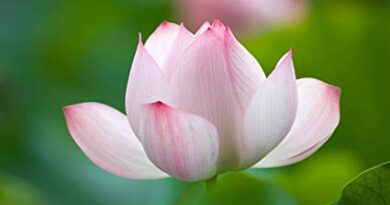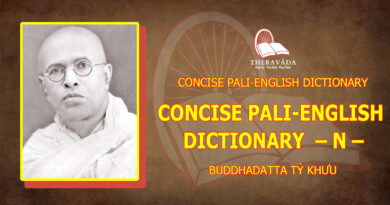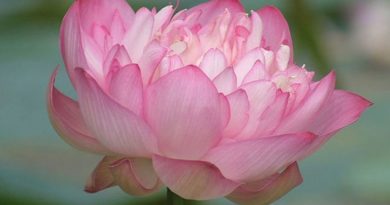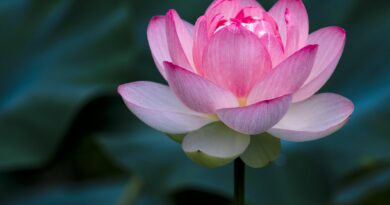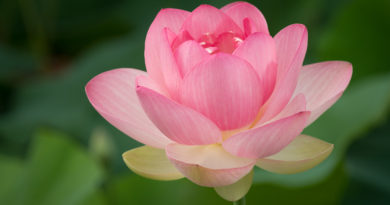HANDBOOK FOR MANKIND – 1. LOOKING AT BUDDHISM
HANDBOOK FOR MANKIND – 1. LOOKING AT BUDDHISM
If we open any recent book on the origins of religion, we find that there is one point on which all authors are in agreement. They all agree in saying that religion arose in the world out of fear. Primitive forest-dwelling man feared thunder and lightning, darkness and storms, and various things about him that he was unable to understand or control. His method of avoiding the danger he saw in these phenomena was to demonstrate either humility and submission or homage and reverence, depending on which he felt was most appropriate. Later, as man’s knowledge and understanding developed, this fear of the forces of nature changed into a fear of phenomena more difficult to apprehend. Religions based on deference to objects of fear such as natural phenomena, spirits and celestial beings, came to be looked down upon as unreasonable and ridiculous. And then man’s fear became still more refined into a fear of suffering, suffering of the sort that cannot be alleviated by any material means. He came to fear the suffering inherent in birth, ageing, pain and death, the disappointment and hopelessness which arise out of desire, anger and stupidity, which no amount of power or wealth can relieve. Long ago in India, a country well provided with thinkers and investigators, intelligent people dispensed with all paying of homage to supernatural beings and started seeking instead the means of conquering birth, ageing, pain and death, the means of eliminating greed, hatred and delusion. Out of this search arose Buddhism, a higher religion based on insight, a means of conquering birth, ageing, pain and death, a method for destroying the mental defilements. Buddhism has its origins in fear of this last kind, just as do all religions based on intelligence The Buddha discovered how to conquer absolutely what man fears: he discovered a practical method, now called Buddhism for eliminating suffering.
“Buddhism” means “the Teaching of the Enlightened One.” A Buddha is an enlightened individual, one who knows the truth about all things, one who knows just what is what, and so is capable of behaving appropriately with respect to all things. Buddhism is a religion based on intelligence, science and knowledge, whose purpose is the destruction of suffering and the source of suffering. All paying of homage to sacred objects by means of performing rites and rituals, making offerings or praying is not Buddhism. The Buddha rejected all this as foolish, ridiculous and unsound. He also rejected the celestial beings, then considered by certain groups to be the creator of things, and the deities supposed to dwell, one in each star in the sky. Thus we find that the Buddha made such statements as these:
“Knowledge, skill and ability are conducive to success and benefit and are auspicious omens, good in their own right regardless of the movements of the heavenly bodies. With the benefits gained from these qualities, one will completely outstrip those foolish people who just sit making their astrological calculations.” And: “If the water in rivers (such as the Ganges) could really wash away sins and suffering, then the turtles, crabs, fish and shellfish living in those sacred rivers ought by now to be freed of their sins and sufferings too.” And: “If a man could eliminate suffering by making offerings, paying homage and praying, there would be no one subject to suffering left in the world, because anyone at all can pay homage and pray. But since people are still subject to suffering while in the very act of making obeisances, paying homage and performing rites, this is clearly not the way to gain liberation.”
To attain liberation, we first have to examine things closely in order to come to know and understand their true nature. Then we have to behave in a way appropriate to that true nature. This is the Buddhist teaching; this we must know and bear in mind. Buddhism has nothing to do with prostrating oneself and deferring to awesome things. It sets no store by rites and ceremonies such as making libations of holy water, or any externals whatsoever, spirits and celestial being included. On the contrary, it depends on reason and insight. Buddhism does not demand conjecture or supposition; it demands that we act in accordance with what our own insight reveals and not take anyone else’s word for anything. If someone comes and tells us something, we must not believe him without question. We must listen to his statement and examine it. Then if we find it reasonable, we may accept it provisionally and set about trying to verify it for ourselves. This is a key feature of Buddhism, which distinguishes it sharply from other world religions.
Now a religion is a many-sided thing. Seen from one angle it has a certain appearance; seen from another angle, it has another. Many people look at religion from the wrong angle, and Buddhism is no exception. Different individuals looking at Buddhism with different mental attitudes are bound to get different views of it. Because each of us naturally has confidence in his own opinions, the truth for each of us coincides with our own particular understanding and point of view. Consequently, “the Truth” is not quite the same thing for different people. They all penetrate questions to varying depth by varying methods, and with varying degrees of intelligence A person does not recognize as true, according to his own ideas of the Truth, anything that lies beyond his own intelligence, knowledge and understanding. And even though he may outwardly go along with other people’s ideas as to what is the truth, he knows in himself that it is not the truth as he himself sees it. Each person’s conception of the truth may change and develop with the day by day increase in his degree of intelligence, knowledge and understanding, until such time as he arrives at the ultimate truth; and each of us has different ways of examining and testing before believing. So if Buddhism is viewed with differing degrees of intelligence, differing pictures of it will be seen, simply because it can be viewed from an aspect. As we have said, Buddhism is a practical method for liberating oneself from suffering by means of coming to realize as did the Buddha himself, the true nature of things. Now any religious text is bound to contain material which later people have found occasion to add to, and our Tipitaka is no exception. People in later ages have added sections based on then current ideas, either in order to boost people’s confidence or out of excessive religious zeal. Regrettably even the rites and rituals which have developed and become mixed in with the religion are now accepted and recognized as Buddhism proper. Ceremonies, such as setting up trays of sweets and fruit as offerings to the “soul” of the Buddha in the same way as alms food is offered to a monk just do not fit in with Buddhist principles. Yet some groups consider this to be genuine Buddhist practice, teaching it as such and keeping to it very strictly.
Rites and ceremonies of this kind have become so numerous that they now completely obscure the real Buddhism and its original purpose. Take for example the procedure of becoming ordained a monk. There has come into existence the ceremony of making gifts to the newly ordained bhikkhu Guests are invited to bring food and to watch proceedings, and as a result, there is much drunkenness and noise. Ceremonies are performed both at the temple and in the home. The new bhikkhu later leaves the Order again only a few days after having been ordained, and may become an even stronger temple-hater than he was before. It must be borne in mind that there was none of this at the time of the Buddha. It is a later development. Ordination at the time of the Buddha meant simply, that some individual, who had obtained his parent’s consent, renounced home and family. He was a person who was able to close accounts at home and go off to join the Buddha and the Order of bhikkhus. On some convenient occasion he would go and be ordained, and perhaps not see his parents or family again for the rest of his life. Though some bhikkhus might go back to visit their parents again on suitable occasions, this was rare. There does exist a rule permitting a bhikkhu to go home when there is a good reason for doing so, but at the time of the Buddha this was not the done thing. Bhikkhus did not receive ordination with their parents in attendance nor did they celebrate the event as a great occasion, only to leave the Sangha again after just a few days, no better off than at first, as commonly happens in the present day.
All this presenting of gifts to newly ordained bhikkhus, this performing of ceremonies, including all sorts of celebration – this we are foolish enough to call Buddhism! Furthermore we choose to make much of it, thinking nothing of spending all our own money, or other people’s on account of it. This “Neo-Buddhism” is so widespread as to be almost universal. The Dhamma, the genuine teaching that once was paramount has become so overlaid by ceremonial that the whole objective of Buddhism has been obscured, falsified and changed. Ordination, for instance, has become a face-saving gambit for young men whom people have been pointing at for never having been ordained, or a prerequisite to finding a wife (as having been a monk is considered a sign of maturity), or is done with some other kind of ulterior motive. In some places an ordination is regarded as an opportunity for collecting money for which job there are always people on hand to help. It is one way of getting rich. Even this they call Buddhism! And anyone who goes and criticizes this is considered to be ignorant of Buddhism or opposed to it.
Another example is the presentation of kathina cloth The Buddha’s original intention was to have cloth for robes given to all the bhikkhus simultaneously so that they could sew it together themselves with a minimum loss of time. If there was only one robe, it was allocated to some bhikkhu not necessarily the most senior one, whom the group considered worthy of using that role or in need of it, and was presented to him in the name of the entire order. The Buddha’s intention was to avoid any bhikkhu’s having a high opinion of himself. On that day everyone, regardless of rank, had to humble himself and be one of the crowd. Everyone had to lend a hand cutting and sewing the cloth, boiling tree pith to make the dye, and whatever else was involved in getting the robes ready and finished the same day. Making the cloth into robes was a co-operative effort. That is how the Buddha intended it to be, an event not necessarily involving lay people at all. But nowadays it has become an affair involving ceremony, fun and games, loud laughter and money seeking. It is just a picnic and is devoid of all the desirable results originally intended.
This sort of thing is a tumour which has developed in Buddhism and thrived. The tumour takes hundreds of different forms too numerous to name. It is a dangerous, malignant growth which by degrees has completely overlaid and obscured the good material, the real pith of Buddhism, and quite disfigured it. One result of this has been the arising of many sects, some large, some insignificant, as off-shoots from the original religion. Some sects have even become involved in sensuality. It is essential that we always discriminate in order to recognize what is the real, original Buddhism. We must not foolishly grasp at the outer shell, or become so attached to the various rituals and ceremonies that the real objective becomes quite lost to view. The real practice of Buddhism is based on purification of conduct by way of body and speech, followed by purification of the mind, which in its turn leads to insight and right understanding. Don’t go thinking that such and such is Buddhism just because everyone says it is. The tumour has been spreading constantly since the day the Buddha died, expanding in all directions right up to the present day, so that it is now quite sizeable. The tumour in Buddhism must not be misidentified as Buddhism itself. It is also wrong for of other religions to come and point at these shameful disgraceful growths as being Buddhism. It is unjust, because these things are not Buddhism at all; they are excrescence. Those of us interested in furthering Buddhism, whether as a foothold for all people, or for our own private well-being, must know how to get hold of the true essence of Buddhism and not just grab at some worthless outgrowth. Now even the genuine Buddhism is many-sided, a fact which may lead to a false grasp of true meaning. For instance, if looked at from the point of view of a moral philosopher, Buddhism is seen to be a religion of morality. There is talk of merit and demerit, good and evil, honesty, gratitude, harmony, open-heartedness and much more besides. The Tipitaka is full of moral teachings. Many newcomers to Buddhism approach it from this angle and are attracted to it on this account.
A more profound aspect is Buddhism as Truth, as the deep hidden truth lying below the surface and invisible to the ordinary man. To see this truth is to know intellectual emptiness of all things; the transience, unsatisfactoriness and non-selfhood of all things; to know intellectually the nature of suffering, of the complete elimination of suffering and of the way to attain the complete elimination of suffering; to perceive these in terms of absolute truth, the kind that changes and which everyone ought to know. This is Buddhism as Truth.
Buddhism as Religion is Buddhism as a system of practice based on morality, concentration and insight, and culminating in liberating insight; a system which when practised to completion enables one to break free from suffering. This is Buddhism as Religion.
Then there is Buddhism as Psychology, as it is presented to us in the third section of the Tipitaka, where the nature of the mind is described in remarkable detail. Buddhist psychology is a source of interest and astonishment to students of the mind even in the present day. It is far more detailed and profound than present day psychological knowledge.
Another aspect is Buddhism as Philosophy. Philosophical knowledge can be clearly seen by means of reasoned logical proofs but cannot be demonstrated experimentally. It contrasts with science, which is knowledge resulting from seeing something clearly, with our eyes, or through physical experimentation and proof, or even with the “inner eye” of intuition. Profound knowledge such as that of emptiness is just philosophy for a person who has not yet penetrated to the truth, and science for another who has done so, such as a fully enlightened individual, or arahant, who has seen it clearly, intuitively. Many aspects of Buddhism, in particular the Four Noble Truths, are scientific in so far as they can be verified by clear experimental proof using introspection. For anyone equipped with awareness and interested in studying and carrying out research, the cause – effect relationships are there just as in science. Buddhism is not just something obscure and vague, not just philosophy, as are man-made subjects.
Some look on Buddhism as Culture. Anyone with a high regard for culture finds many aspects of Buddhist practice which are common to all cultures and also many that are characteristically Buddhist and far better and higher than anything in other cultures.
Of all these various aspects, the one a real Buddhist ought to take most interest in is Buddhism as Religion. We ought to look on Buddhism as a direct practical method for gaining knowledge of the true nature of things, knowledge which makes it possible to give up every form of grasping and clinging, of stupidity and infatuation, and become completely independent of things. To do this is to penetrate to the essence of Buddhism. Buddhism considered in this aspect is far more useful than Buddhism considered as mere morality, or as truth which is simply profound knowledge and not really practical; and more useful than Buddhism considered as philosophy, as something to be enjoyed as an object of speculation and argument of no value in the giving up of the mental defilements; and certainly more useful than Buddhism considered simply as culture, as attractive behaviour, noteworthy from the sociological viewpoint.
At the very least, everyone ought to consider Buddhism as Art, as the Art of Living – in other words, as skill and competence in being a human being, living in a way that is exemplary and praiseworthy, which so impresses others that they automatically wish to emulate it. What we have to do is to cultivate the “Three Lustres,” firstly developing moral purity, training the mind to be tranquil and steady and fit to its job, and finally developing such an abundance of wisdom and clear insight into the nature of all things that those things are no longer able to give rise to suffering. When anyone’s life has these Three Lustres, he can be considered to have mastered the art of living. Westerners are extremely interested in Buddhism as the Art of Living, and discuss this aspect more than any other. Penetrating so far into the real essence of Buddhism that we are able to take it as our guide to living induces spiritual good cheer and joy, dispersing depression and disillusionment. It also dispels fears, such as the fear that the complete giving up of spiritual defilements would make life dry and dreary and utterly devoid of flavour, or the fear that complete freedom from craving would make all thought and action impossible, whereas in reality a person who organizes his life in accordance with the Buddhist Art of Living is victor over all the things about him. Regardless of whether these things be animals, people, possessions, or anything else, and regardless of whether they enter that person’s consciousness by way of the eye, ear, nose, tongue, body, or mind, they will enter as losers, unable to becloud, defile, or perturb him. The winning of victory over all things is genuine bliss.
Buddha-Dhamma will enrapture a mind that has developed a taste for it. It can be considered an indispensable form of nourishment too. True, a person still controlled by the defilements continues to desire nourishment by way of the eye, ear, nose, tongue and body and goes in search of it as suits his nature. But there is another part of him, something deeper, that does not demand that sort of nourishment. It is the free or pure element in his mind. It wishes the joy and delight of spiritual nourishment, starting with the delight that results from moral purity. It is the source of contentment for fully enlightened individuals, who possess such tranquillity of mind that defilements cannot disturb them, who possess clear insight into the true nature of all things and have no ambitions with regard to any of them. They are, so to speak, able to sit down without being obliged to run hither and yon like those people to whom the Buddha applied the simile “smoke by night, fire by day.”
“Smoke by night” refers to sleeplessness, restlessness. A sufferer from this complaint lies all night with hand on brow, planning on going after this and that, working out how to get money, how to get rich quickly and get the various things he desires. His mind is full of “smoke.” All he can do is lie there until morning, when he can get up and go running off in obedience to the wishes of the “smoke” he has been holding back all night. This fervent activity is what the Buddha referred to as “fire by day.” These are the symptoms of a mind that has not achieved tranquillity, a mind that has been deprived of spiritual nourishment. It is a pathological hunger and thirst induced by the defilement called craving. All night long the victim represses the smoke and heat, which in the morning becomes fire, and then blazes hot inside him all day. If a person is obliged, throughout his entire life, to suppress the “smoke by night,” which then becomes “fire by day,” how can he ever find peace and coolness? Just visualize his condition. He endures suffering and torment all his life, from birth up until he enters the coffin, simply for lack of the insight that could completely extinguish that fire and smoke. To treat such a complaint one has to make use of the knowledge provided by the Buddha. The smoke and fire diminish in proportion to one’s degree of understanding of the true nature of things.
As we have said, Buddhism has a number of different aspects or sides. Just as the same mountain when viewed from a different direction presents a different appearance, so different benefits are derived from Buddhism according to how one looks at it. Even Buddhism has its origins in fear–not the foolish fear of an ignorant person who kneels and makes obeisance to idols or strange phenomena, but a higher kind of fear, the fear of perhaps never attaining liberation from the oppression of birth, ageing, pain and death, from the various forms of suffering we experience. The real Buddhism is not books, not manuals, not word for word repetition from the Tipitaka, nor is it rites and rituals. These are not the real Buddhism. The real Buddhism is the practice, by way of body, speech and mind that will destroy the defilements, in part or completely. One need not have anything to do with books or manuals. One ought not to rely on rites and rituals, or anything else external, including spirits and celestial beings. Rather one must be directly concerned with bodily action, speech and thought. That is, one must persevere in one’s efforts to control and eliminate the defilements so that clear insight can arise. One will then be automatically capable of acting appropriately, and will be free of suffering from that moment right up to the end.
This is the real Buddhism. This is what we have to understand. Let us not go foolishly grasping at the tumour that is obscuring Buddhism, taking it for the real thing.


